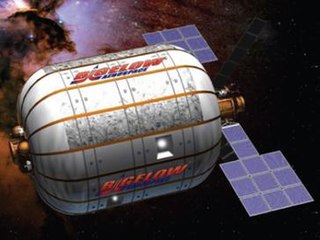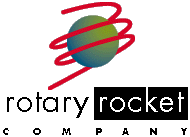
Space tourism is space travel for recreational, leisure or business purposes. There are several different types of space tourism, including orbital, suborbital and lunar space tourism. To date, orbital space tourism has been performed only by the Russian Space Agency. Work also continues towards developing suborbital space tourism vehicles. This is being done by aerospace companies like Blue Origin and Virgin Galactic. In addition, SpaceX announced in 2018 that it is planning on sending two space tourists on a free-return trajectory around the Moon on the upper stage of SpaceX's BFR rocket, known as the Big Falcon Spaceship (BFS).

The National Space Society (NSS) is an American international nonprofit 501(c)(3) educational and scientific organization specializing in space advocacy. It is a member of the Independent Charities of America and an annual participant in the Combined Federal Campaign. The society's vision is: "People living and working in thriving communities beyond the Earth, and the use of the vast resources of space for the dramatic betterment of humanity."

Space law is the body of law governing space-related activities, encompassing both international and domestic agreements, rules, and principles. Parameters of space law include space exploration, liability for damage, weapons use, rescue efforts, environmental preservation, information sharing, new technologies, and ethics. Other fields of law, such as administrative law, intellectual property law, arms control law, insurance law, environmental law, criminal law, and commercial law, are also integrated within space law.
The International Space Development Conference (ISDC) is the annual conference of the National Space Society (NSS). Now in its 37th year, these conferences connect the general public and the NSS membership with leaders of contemporary space efforts. The ISDC provides a nexus for industry, government, scientists, advocates, and the public to meet and discuss the latest issues in space technology, science, policy, commerce, medicine, exploration, settlement and much more. Winners of the annual NASA space settlement Contest annually attend the conference, with several interesting activities and programs. With National Space Society's major goal being to accelerate the process of space exploration and development they also foster astronautics for students by encouraging them and getting them involved.
The Aerospace Corporation is a California nonprofit corporation that operates a federally funded research and development center (FFRDC) headquartered in El Segundo, California. The corporation provides technical guidance and advice on all aspects of space missions to military, civil, and commercial customers. As the FFRDC for national-security space, Aerospace works closely with organizations such as the United States Air Force Space and Missile Systems Center (SMC) and the National Reconnaissance Office (NRO) to provide "objective technical analyses and assessments for space programs that serve the national interest". Although SMC and NRO are the primary customers, Aerospace also performs work for civil agencies as well as international organizations and governments in the national interest.

The B330 is an inflatable space habitat being privately developed by Bigelow Aerospace. The design was evolved from NASA's TransHab habitat concept. B330 will have 330 cubic meters (12,000 cu ft) of internal volume, hence its numeric designation.

Commercial use of space is the provision of goods or services of commercial value by using equipment sent into Earth orbit or outer space. Examples of the commercial use of space include satellite navigation, satellite television and commercial satellite imagery. Operators of such services typically contract the manufacturing of satellites and their launch to private or public companies, which form an integral part of the space economy. Some commercial ventures have long-terms plans to exploit natural resources originating outside Earth, for example asteroid mining. Space tourism, currently an exceptional activity, could also be an area of future growth, as new businesses strive to reduce the costs and risks of human spaceflight.
The space policy of the George W. Bush administration is mainly associated with the Vision for Space Exploration, announced in 2004. A formal National Space Policy was released in 2006.

Inflatable habitats or expandable habitats are pressurized structures capable of supporting life in outer space whose internal volume increases after launch. They have frequently been proposed for use in space applications to provide a greater volume of living space for a given mass.
Space policy is the political decision-making process for, and application of, public policy of a state regarding spaceflight and uses of outer space, both for civilian and military purposes. International treaties, such as the 1967 Outer Space Treaty, attempt to maximize the peaceful uses of space and restrict the militarization of space.
NewSpace, or new space, is a term for a movement and philosophy encompassing a globally emerging private spaceflight industry. Specifically, the term is used to refer to a global sector of new aerospace companies and ventures working independently of governments and traditional major contractors to develop faster, better, and cheaper access to space and spaceflight technologies, driven by commercial, as distinct from political or other, motivations to broader, more socioeconomically-oriented, ends.
The Bigelow Next-Generation Commercial Space Station is a private orbital space station currently under development by Bigelow Aerospace. Previous concepts of the space station had included multiple modules such as two B330 expandable spacecraft modules as well as a central docking node, propulsion, solar arrays, and attached crew capsules. However it now appears that each B330 can operate as an independent space station. Attaching a B330 to the International Space Station or flying a B330 alone have been suggested by Robert Bigelow.

Japan's space exploration originated in the mid-1950s as a research group led by Hideo Itokawa at the University of Tokyo. Rocket sizes increased gradually from less than 30 cm (12 in) at the start of the project to over 15 m (49 ft) in the mid-1960s. The aim of the original research project was to launch a man-made satellite.
Deep Space Industries, or DSI, was an American privately-held company operating in the space technology and space exploration sectors. The company is developing and building spacecraft technology that allows private companies and government agencies to access destinations throughout the solar system. DSI's stated goal is to democratize access to deep space by fundamentally changing the paradigm for accessing deep space and substantially lowering the cost. On Jan. 1, 2019 DSI was acquired by Bradford Space.
NASA Alumni League is a U.S. organization that supports people that have for example worked at NASA, to stay connected. The organization operates across the nation, also with state chapters that allow patrons to network locally. Three goals of NAL in the early 21st century were to "communicate with the NASA community", "to aid the NASA community with its comprehension of engineering and science, and "encourage members to participate in community service and in turn, encourage a dedication to the pursuit of scientific knowledge that benefits all humankind. " NAL is not part of NASA or the U.S. government, it is a non-profit organization founded in 1986.
Airbus Defence and Space is a division of Airbus responsible for defence and aerospace products and services. The division was formed in January 2014 during the corporate restructuring of European Aeronautic Defence and Space (EADS), and comprises the former Airbus Military, Astrium, and Cassidian divisions. It is the world's second largest space company after Boeing and one of the top ten defence companies in the world.

Students for the Exploration and Development of Space (SEDS) is an international student organization whose purpose is to promote space exploration and development through educational and engineering projects.















